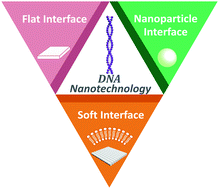Bioapplications of DNA nanotechnology at the solid–liquid interface
Abstract
DNA nanotechnology engineered at the solid–liquid interface has advanced our fundamental understanding of DNA hybridization kinetics and facilitated the design of improved biosensing, bioimaging and therapeutic platforms. Three research branches of DNA nanotechnology exist: (i) structural DNA nanotechnology for the construction of various nanoscale patterns; (ii) dynamic DNA nanotechnology for the operation of nanodevices; and (iii) functional DNA nanotechnology for the exploration of new DNA functions. Although the initial stages of DNA nanotechnology research began in aqueous solution, current research efforts have shifted to solid–liquid interfaces. Based on shape and component features, these interfaces can be classified as flat interfaces, nanoparticle interfaces, and soft interfaces of DNA origami and cell membranes. This review briefly discusses the development of DNA nanotechnology. We then highlight the important roles of structural DNA nanotechnology in tailoring the properties of flat interfaces and modifications of nanoparticle interfaces, and extensively review their successful bioapplications. In addition, engineering advances in DNA nanodevices at interfaces for improved biosensing both in vitro and in vivo are presented. The use of DNA nanotechnology as a tool to engineer cell membranes to reveal protein levels and cell behavior is also discussed. Finally, we present challenges and an outlook for this emerging field.



 Please wait while we load your content...
Please wait while we load your content...